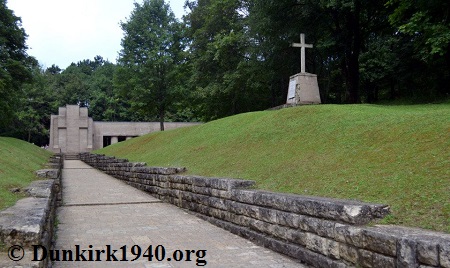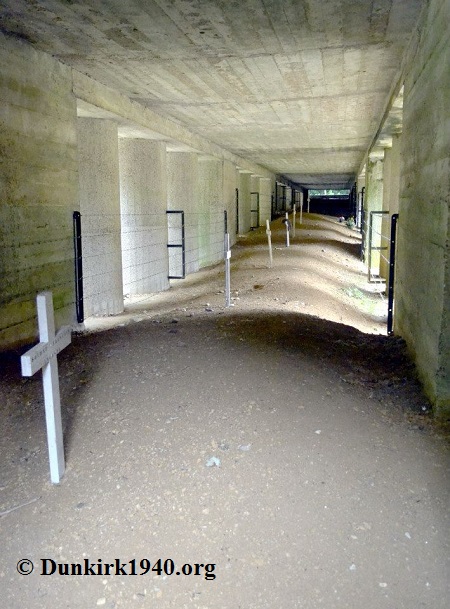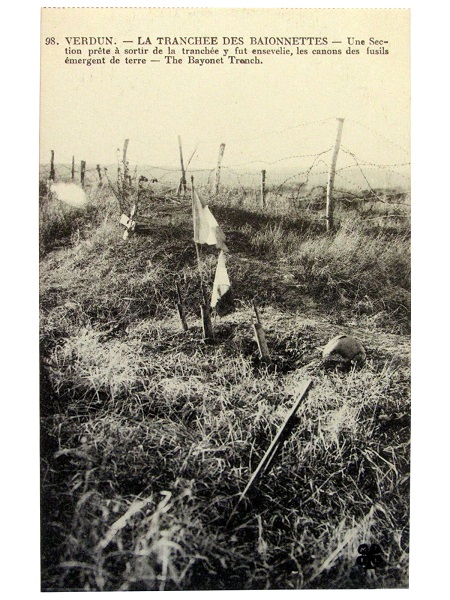
The 137eme RI will be forever linked with the legend of the Trench of the Bayonets at Verdun. On June 12th 1916, at the height of the fighting at Verdun, the section of trench held by the 3eme Company of the 137eme came under direct bombardment from the Germans. Already cut off from the rest of the main French line by June 10th and having sustained 94 dead from its original strength of 164 men, the remaining troops were buried alive under this bombardment.

In the years after WW1, the French Army put a great deal of effort into seeking out their war dead; what they discovered was a complete section of trench completely filled in, with the bayonets of French troops protruding from the ground at intervals. These were still fixed to the rifles and further excavations revealed that each of these had a corpse below. Far from fleeing when having come under attack, the troops had remained at post.

The regiment's Colonel oversaw the erection of a small wooden cross in January of 1919, although the modern visitor is now greeted with a memorial funded by Mr Rand, an American who generously funded the elaborate structure; opened by the then French President Millerand on December 8th, 1920. Having visited the site over some 30 years, I note that the number and nature of the bayonets protruding from the ground have altered on an almost annual basis. However, it remains a powerful reminder of the nature of modern warfare.

Postcard depicting the trench in the immediate postwar period.
Insignia of the 137eme RI.
 137e Regiment d'Infanterie – Part of the 21st Infantry Division engaged in a heroic defence, initially of the south-west of the Dunkirk inner defensive perimeter, around Saint-Georges and Bourbourg. Finally, the regiment took part in a last French counter-attack and subsequent last stand around the village of Teteghem on the 3rd June, 1940. In doing so, they prevented a decisive German breakthrough to the Dunkirk beaches and harbour and bought a further 24 hours of time for the final evacuation effort.
137e Regiment d'Infanterie – Part of the 21st Infantry Division engaged in a heroic defence, initially of the south-west of the Dunkirk inner defensive perimeter, around Saint-Georges and Bourbourg. Finally, the regiment took part in a last French counter-attack and subsequent last stand around the village of Teteghem on the 3rd June, 1940. In doing so, they prevented a decisive German breakthrough to the Dunkirk beaches and harbour and bought a further 24 hours of time for the final evacuation effort.
Back
 137e Regiment d'Infanterie – Part of the 21st Infantry Division engaged in a heroic defence, initially of the south-west of the Dunkirk inner defensive perimeter, around Saint-Georges and Bourbourg. Finally, the regiment took part in a last French counter-attack and subsequent last stand around the village of Teteghem on the 3rd June, 1940. In doing so, they prevented a decisive German breakthrough to the Dunkirk beaches and harbour and bought a further 24 hours of time for the final evacuation effort.
137e Regiment d'Infanterie – Part of the 21st Infantry Division engaged in a heroic defence, initially of the south-west of the Dunkirk inner defensive perimeter, around Saint-Georges and Bourbourg. Finally, the regiment took part in a last French counter-attack and subsequent last stand around the village of Teteghem on the 3rd June, 1940. In doing so, they prevented a decisive German breakthrough to the Dunkirk beaches and harbour and bought a further 24 hours of time for the final evacuation effort.Back
